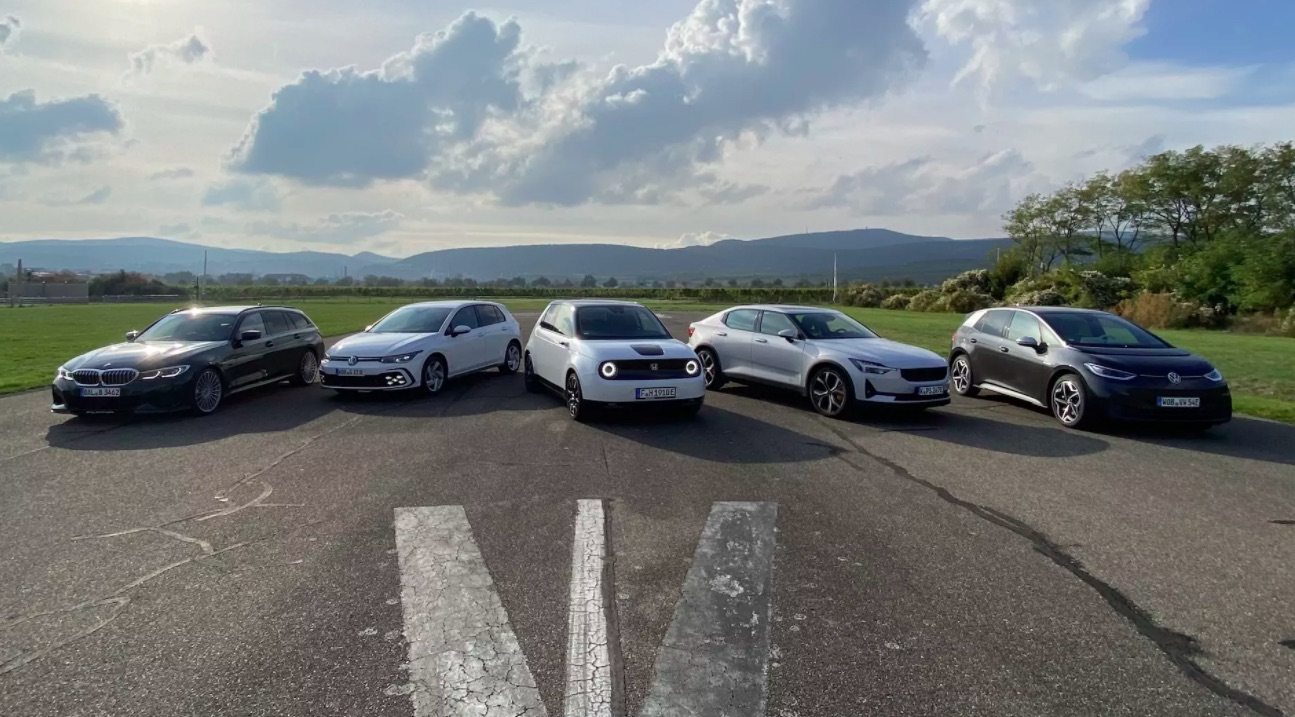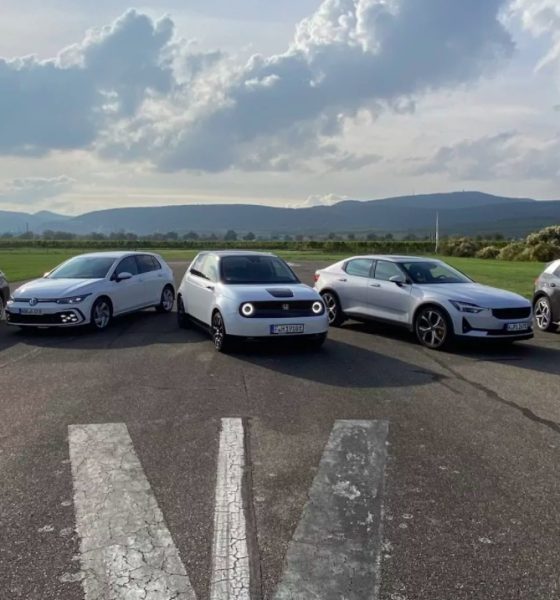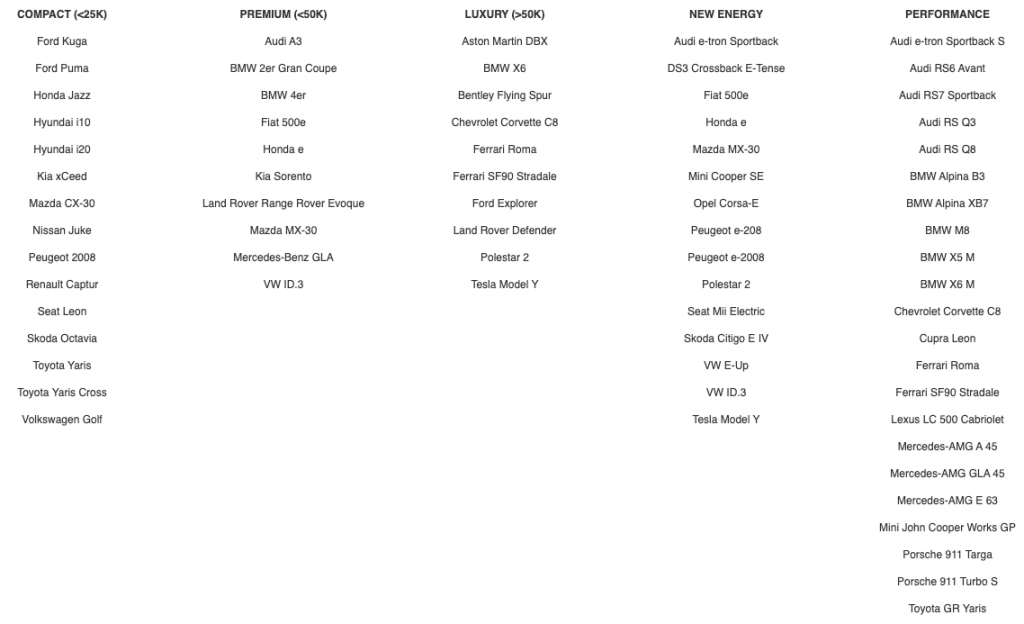

News
Tesla Model Y shunned in favor of Polestar 2 and Honda e in 2021 German Car of the Year awards
The Tesla Model Y may have made it as a nominee in the 2021 German Car of the Year awards’ “Luxury” and “New Energy” categories, but the all-electric crossover from California was ultimately pushed aside in favor of two fellow EVs, the Polestar 2 and the Honda e.
The winners of the 2021 German Car of the Year awards are selected by a panel of 18 motoring journalists, all of whom maintain a high standing in their respective fields. The overall Car of the Year award will be selected from the final five category winners.
As could be seen on the official website of the 2021 German Car of the Year awards, the Polestar 2 came away as the winner of the “Luxury” category, beating out vehicles like the Tesla Model Y, Ferrari Roma, Aston Martin DBX, and the Bentley Flying Spur. Thomas Ingenlath, CEO of Polestar, in a statement to The Driven, expressed his appreciation for the award.

“It has always been our aim to bring more than just an electric alternative to the market, to develop a car that inspires customers with its design, innovation, and performance. We are proud that the jury has recognized Polestar 2 in this way,” Ingenlath said.
In the “New Energy” category, the 2021 German Car of the Year panel selected the Honda e to be this year’s winner. The small EV from the Japanese carmaker beat out a number of heavyweights to earn its title, including the Tesla Model Y, the Polestar 2, the Audi e-tron Sportback, and the Volkswagen ID.3. Nozomu Yamashiro, president of Honda Germany, shared his enthusiasm with the award.
“The Honda e is at the heart of Honda’s advanced electrification strategy that goes beyond mere mobility. We are very happy to be winners in this future-oriented category. Honda will continue to provide its customers in Germany with innovative technologies in order to drive progress in the field of mobility and everyday life,” Yamashiro said.
The Volkswagen ID.3, a vehicle that was test-driven by Tesla CEO Elon Musk during his recent visit to Germany, was a winner in its own right. The all-electric hatchback won the “Premium” category, beating out vehicles like the Mercedes-Benz GLA, BMW 2er Gran Coupe, and the Honda e. The “Compact” and “Performance” categories were won by the Volkswagen Golf and BMW Alpina B3, respectively.
This is not the first year that Tesla’s vehicles were seemingly shunned in the German Car of the Year awards. Last year, for example, the vehicle that came away as the overall 2020 Car of the Year was the Porsche Taycan, and in 2019, it was the Jaguar I-PACE. Perhaps, with Gigafactory Berlin coming online in the coming year and producing the Model Y locally, the all-electric crossover could go beyond just being a nominee in the German Car of the Year awards.

News
Tesla FSD fleet is nearing 7 billion total miles, including 2.5 billion city miles
As can be seen on Tesla’s official FSD webpage, vehicles equipped with the system have now navigated over 6.99 billion miles.

Tesla’s Full Self-Driving (Supervised) fleet is closing in on almost 7 billion total miles driven, as per data posted by the company on its official FSD webpage.
These figures hint at the massive scale of data fueling Tesla’s rapid FSD improvements, which have been quite notable as of late.
FSD mileage milestones
As can be seen on Tesla’s official FSD webpage, vehicles equipped with the system have now navigated over 6.99 billion miles. Tesla owner and avid FSD tester Whole Mars Catalog also shared a screenshot indicating that from the nearly 7 billion miles traveled by the FSD fleet, more than 2.5 billion miles were driven inside cities.
City miles are particularly valuable for complex urban scenarios like unprotected turns, pedestrian interactions, and traffic lights. This is also the difference-maker for FSD, as only complex solutions, such as Waymo’s self-driving taxis, operate similarly on inner-city streets. And even then, incidents such as the San Francisco blackouts have proven challenging for sensor-rich vehicles like Waymos.
Tesla’s data edge
Tesla has a number of advantages in the autonomous vehicle sector, one of which is the size of its fleet and the number of vehicles training FSD on real-world roads. Tesla’s nearly 7 billion FSD miles then allow the company to roll out updates that make its vehicles behave like they are being driven by experienced drivers, even if they are operating on their own.
So notable are Tesla’s improvements to FSD that NVIDIA Director of Robotics Jim Fan, after experiencing FSD v14, noted that the system is the first AI that passes what he described as a “Physical Turing Test.”
“Despite knowing exactly how robot learning works, I still find it magical watching the steering wheel turn by itself. First it feels surreal, next it becomes routine. Then, like the smartphone, taking it away actively hurts. This is how humanity gets rewired and glued to god-like technologies,” Fan wrote in a post on X.
News
Tesla starts showing how FSD will change lives in Europe
Local officials tested the system on narrow country roads and were impressed by FSD’s smooth, human-like driving, with some calling the service a game-changer for everyday life in areas that are far from urban centers.

Tesla has launched Europe’s first public shuttle service using Full Self-Driving (Supervised) in the rural Eifelkreis Bitburg-Prüm region of Germany, demonstrating how the technology can restore independence and mobility for people who struggle with limited transport options.
Local officials tested the system on narrow country roads and were impressed by FSD’s smooth, human-like driving, with some calling the service a game-changer for everyday life in areas that are far from urban centers.
Officials see real impact on rural residents
Arzfeld Mayor Johannes Kuhl and District Administrator Andreas Kruppert personally tested the Tesla shuttle service. This allowed them to see just how well FSD navigated winding lanes and rural roads confidently. Kruppert said, “Autonomous driving sounds like science fiction to many, but we simply see here that it works totally well in rural regions too.” Kuhl, for his part, also noted that FSD “feels like a very experienced driver.”
The pilot complements the area’s “Citizen Bus” program, which provides on-demand rides for elderly residents who can no longer drive themselves. Tesla Europe shared a video of a demonstration of the service, highlighting how FSD gives people their freedom back, even in places where public transport is not as prevalent.
What the Ministry for Economic Affairs and Transport says
Rhineland-Palatinate’s Minister Daniela Schmitt supported the project, praising the collaboration that made this “first of its kind in Europe” possible. As per the ministry, the rural rollout for the service shows FSD’s potential beyond major cities, and it delivers tangible benefits like grocery runs, doctor visits, and social connections for isolated residents.
“Reliable and flexible mobility is especially vital in rural areas. With the launch of a shuttle service using self-driving vehicles (FSD supervised) by Tesla in the Eifelkreis Bitburg-Prüm, an innovative pilot project is now getting underway that complements local community bus services. It is the first project of its kind in Europe.
“The result is a real gain for rural mobility: greater accessibility, more flexibility and tangible benefits for everyday life. A strong signal for innovation, cooperation and future-oriented mobility beyond urban centers,” the ministry wrote in a LinkedIn post.
News
Tesla China quietly posts Robotaxi-related job listing
Tesla China is currently seeking a Low Voltage Electrical Engineer to work on circuit board design for the company’s autonomous vehicles.

Tesla has posted a new job listing in Shanghai explicitly tied to its Robotaxi program, fueling speculation that the company is preparing to launch its dedicated autonomous ride-hailing service in China.
As noted in the listing, Tesla China is currently seeking a Low Voltage Electrical Engineer to work on circuit board design for the company’s autonomous vehicles.
Robotaxi-specific role
The listing, which was shared on social media platform X by industry watcher @tslaming, suggested that Tesla China is looking to fill the role urgently. The job listing itself specifically mentions that the person hired for the role will be working on the Low Voltage Hardware team, which would design the circuit boards that would serve as the nervous system of the Robotaxi.
Key tasks for the role, as indicated in the job listing, include collaboration with PCB layout, firmware, mechanical, program management, and validation teams, among other responsibilities. The role is based in Shanghai.
China Robotaxi launch
China represents a massive potential market for robotaxis, with its dense urban centers and supportive policies in select cities. Tesla has limited permission to roll out FSD in the country, though despite this, its vehicles have been hailed as among the best in the market when it comes to autonomous features. So far, at least, it appears that China supports Tesla’s FSD and Robotaxi rollout.
This was hinted at in November, when Tesla brought the Cybercab to the 8th China International Import Expo (CIIE) in Shanghai, marking the first time that the autonomous two-seater was brought to the Asia-Pacific region. The vehicle, despite not having a release date in China, received a significant amount of interest among the event’s attendees.








